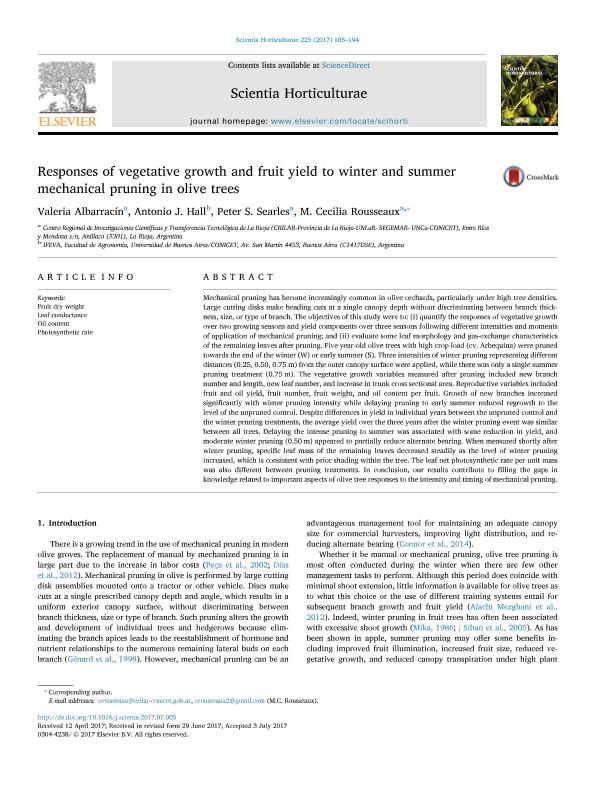Artículo
Responses of vegetative growth and fruit yield to winter and summer mechanical pruning in olive trees
Albarracin, Valeria Mariel ; Hall, Antonio Juan
; Hall, Antonio Juan ; Searles, Peter Stoughton
; Searles, Peter Stoughton ; Rousseaux, Maria Cecilia
; Rousseaux, Maria Cecilia
 ; Hall, Antonio Juan
; Hall, Antonio Juan ; Searles, Peter Stoughton
; Searles, Peter Stoughton ; Rousseaux, Maria Cecilia
; Rousseaux, Maria Cecilia
Fecha de publicación:
11/2017
Editorial:
Elsevier Science
Revista:
Scientia Horticulturae
ISSN:
0304-4238
Idioma:
Inglés
Tipo de recurso:
Artículo publicado
Clasificación temática:
Resumen
Mechanical pruning has become increasingly common in olive orchards, particularly under high tree densities. Large cutting disks make heading cuts at a single canopy depth without discriminating between branch thickness, size, or type of branch. The objectives of this study were to: (i) quantify the responses of vegetative growth over two growing seasons and yield components over three seasons following different intensities and moments of application of mechanical pruning; and (ii) evaluate some leaf morphology and gas-exchange characteristics of the remaining leaves after pruning. Five year-old olive trees with high crop load (cv. Arbequina) were pruned towards the end of the winter (W) or early summer (S). Three intensities of winter pruning representing different distances (0.25, 0.50, 0.75 m) from the outer canopy surface were applied, while there was only a single summer pruning treatment (0.75 m). The vegetative growth variables measured after pruning included new branch number and length, new leaf number, and increase in trunk cross sectional area. Reproductive variables included fruit and oil yield, fruit number, fruit weight, and oil content per fruit. Growth of new branches increased significantly with winter pruning intensity while delaying pruning to early summer reduced regrowth to the level of the unpruned control. Despite differences in yield in individual years between the unpruned control and the winter pruning treatments, the average yield over the three years after the winter pruning event was similar between all trees. Delaying the intense pruning to summer was associated with some reduction in yield, and moderate winter pruning (0.50 m) appeared to partially reduce alternate bearing. When measured shortly after winter pruning, specific leaf mass of the remaining leaves decreased steadily as the level of winter pruning increased, which is consistent with prior shading within the tree. The leaf net photosynthetic rate per unit mass was also different between pruning treatments. In conclusion, our results contribute to filling the gaps in knowledge related to important aspects of olive tree responses to the intensity and timing of mechanical pruning.
Palabras clave:
Fruit Dry Weight
,
Leaf Conductance
,
Oil Content
,
Photosynthetic Rate
Archivos asociados
Licencia
Identificadores
Colecciones
Articulos(CRILAR)
Articulos de CENTRO REGIONAL DE INV. CIENTIFICAS Y TRANSFERENCIA TECNOLOGICA DE ANILLACO
Articulos de CENTRO REGIONAL DE INV. CIENTIFICAS Y TRANSFERENCIA TECNOLOGICA DE ANILLACO
Articulos(IFEVA)
Articulos de INST.D/INV.FISIOLOGICAS Y ECO.VINCULADAS A L/AGRIC
Articulos de INST.D/INV.FISIOLOGICAS Y ECO.VINCULADAS A L/AGRIC
Citación
Albarracin, Valeria Mariel; Hall, Antonio Juan; Searles, Peter Stoughton; Rousseaux, Maria Cecilia; Responses of vegetative growth and fruit yield to winter and summer mechanical pruning in olive trees; Elsevier Science; Scientia Horticulturae; 225; 11-2017; 185-194
Compartir
Altmétricas



